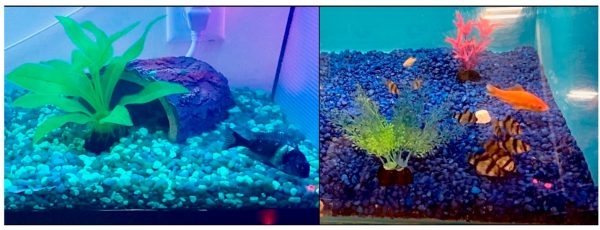Cats and dogs aren’t the only pets fond of chasing things that run away from them. Aquarium fish do it too, as shown in our new peer-reviewed paper that came out just last week in the “Animals” journal! Out of 66 fish species observed, nearly 90% showed interest in or set out to chase moving laser pointed dots.
What makes us especially proud is that the paper came as culmination of a yearlong research that began as our last year’s Fellow Sofia Eisenbeiser’s summer project. As scientists know it all too well, a single year is pretty fast and couldn’t make us more proud!
Another reason for pride is the fact that this research adds another layer of proof to what we’ve been saying all along: (neuro)science doesn’t have to cost a fortune. This particular experiment only requires a couple of things that many people already have: a fish tank with some inhabitants (the more, the merrier!) and a laser pointer or two. Incredibly easy to replicate in, say, your biology classroom!
How Do We Know It’s Play?
Sofia and her co-authors applied five existing criteria to determine whether an animal’s behavior can be classified as play:
- The behavior is “incompletely functional” and does not contribute to immediate survival.
- The behavior is voluntary, spontaneous, intentional, and performed for its own sake.
- The behavior may resemble completely functional behaviors, but it differs in at least one respect, such as context, or is somehow incomplete, exaggerated, or awkward.
- The behavior is repeated consistently during at least a portion of the animal’s life but is not pathological.
- The behavior is begun in the absence of stress, hunger, predation, or circumstances that are otherwise unhealthy.
So they set out to enact, observe, record and classify the behavior in different fish species in response to red, green and blue laser pointer dots dancing around the aquarium. As it turns out, not only do different species show different levels of responsiveness (tiger barbs being the biggest fans of laser tag), but they also have color preferences! Interestingly enough, nearly half of all the observed fish appear to be fond of red. And just like a child gets used to their new toy after a while, our dancing laser dots also seemed to lose some of their appeal after two weeks!
Apart from behavioral scoring, the team also created comparative ethograms (see below) showing the time spent on each behavior, likelihood of transitioning to another behavior, and other relevant parameters.

The paper offers many other questions and possible directions for more research. We are also developing teacher guides and lesson plans to make this easier for you to teach.
